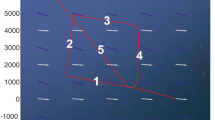Abstract
A precision landing flight test of a tilt-rotor UAV called the TR-60M was performed on shipboard and motion platforms. The ship moved at 10 kt speed on the sea in a sea-state 2 condition, and the motion platform also moved at 10 kt speed between the edges of a runway while simulated with sea-state 2 motion during the flight test. All flight tests were performed using the automatic takeoff, hover, and landing function of TR-60M based on the relative navigation. This is called a real-time kinematic global navigation satellite system (RTK-GNSS). A total of 11 and 10 sorties of automatic takeoff and landing were performed to evaluate the landing accuracy on the running motion platform and shipboard, respectively. The accuracy of the precision landing test satisfied the requirements of shipboard landing in the sea-state 2 condition.

















Similar content being viewed by others
Abbreviations
- AGL:
-
Above ground level
- dx :
-
North position error
- dy :
-
East position error
- dt :
-
Epoch time of an operational flight program (OFP)
- CEP:
-
Circular error probability
- FLDP:
-
Final landing decision point
- GNSS:
-
Global Navigation Satellite System
- GPS:
-
Global Positioning System
- h :
-
Height
- MSL:
-
Mean sea level
- r :
-
Polar position error
- RMS:
-
Root mean square
- TDP:
-
Touchdown point
- UAV:
-
Unmanned air vehicle
- V d :
-
Total speed of ship or deck
- V Ecmd :
-
Speed command in the East direction
- V Ncmd :
-
Speed command in the North direction
- V Tcmd :
-
Total speed command
- VTOL:
-
Vertical takeoff and landing
- V v :
-
Total speed of UAV
- X :
-
Lateral position error on moving deck
- x d :
-
North position of ship or deck
- x v :
-
North position of UAV
- Y :
-
Longitudinal position error on moving deck
- y d :
-
East position of ship or deck
- y v :
-
East position of UAV
- ψ d :
-
Heading angle of ship or deck
- ψ LOS :
-
Heading of line of sight from UAV to ship
- ψ v :
-
Heading angle of UAV
References
Choi SW, Kang Y, Park BJ et al (2013) Implementation of RTK GNSS based relative navigation system for shipboard takeoff and landing of a VTOL UAV. In: KSAS Fall conference, Jeju, Korea, pp 897–901
Kang Y, Park BJ, Cho A et al (2016) Development of flight control system and troubleshooting on flight test of the Smart unmanned aerial vehicle. Int J Aeronaut Space Sci 17(1):120–131. https://doi.org/10.5139/IJASS.2016.17.1.120
Yoo CS, Jang EY, Song BS et al (2016) Land-based flight test for shipboard landing of tilt rotor UAV. In: 30th International council of the aeronautical sciences, Daejeon, p 4
Ernst R, Ferrier B., Sehgal A (2014) Fire scout UAV launch and recovery system performance improvement. 1513-Ferrier, NAVAIR Public Release SPR-2014-0238, AUVSI's Unmanned Systems 2014, Orlando, FL, US, p 24
Settle B, Wise T (2000) Bell Eagle Eye TR-911X: tilt-rotor unmanned aerial vehicle: recent developments, autoland integration, and flight test demonstrations. In: 56th annual forum of American Helicopter Society, Virginia, 2–4 May 2000, pp 306–319
Garratt M, Pota H et al (2009) Visual tracking and LIDAR relative positioning for automated launch and recovery of an unmanned rotorcraft from ships at sea. Naval Eng J 121(2):99–110. https://doi.org/10.1111/j.1559-3584.2009.00194.x
Hardesty M, Kennedy S, Dixon S et al (2013) From fledgling to flight—Boeing’s little bird UAV. Inside GNSS, NJ, US, pp 42–55
Yoo CS, Cho A et al (2014) Sea wave modeling analysis and simulation for shipboard landing of tilt rotor unmanned aerial vehicle. J Korean Soc Aeronaut Space Sci 42(9):731–738. https://doi.org/10.5139/JKSAS.2014.42.9.731
Yoo CS, Park BJ et al (2015) Simulation based on motion platform for tilt rotor UAV shipboard landing. In: 2015 International conference on control, automation and systems (ICCAS 2015), BEXCO, Busan, pp 1747–1750
Applebee TR et al (1974) Response amplitude operator prediction for the USS Belknap (DLG-26) and USS Joseph Hewes (DE 1052) class destroyers. Naval Ship Research and Development Center, Bethesda
Cho A, Yoo CS et al (2015) Implementation of RTK GNSS based relative navigation system for shipboard takeoff and landing of a VTOL UAV. In: KSAS Fall conference, Jeju, Korea, pp 1379–1383
https://www.novatel.com/products/span-gnss-inertial-systems/span-receivers/span-enclosures/span-flexpak6/. Accessed 14 Sept 2018
https://www.novatel.com/products/span-gnss-inertial-systems/span-receivers/span-enclosures/span-on-propak6/. Accessed 14 Sept 2018
https://lightware.co.za/pages/documents. Accessed 14 Sept 2018
Kim P (2013) Rigid body dynamics for beginners: Euler angles & quaternions. Createspace Independent Publishing Platform, Scotts Valley, pp 64–69
Kang Y, Park BJ, Cho A, Yoo CS (2014) Control law design for a tilt-rotor unmanned aerial vehicle with a nacelle mounted WE (wing extension). J Inst Control Robot Syst 20(11):1103–1111. https://doi.org/10.5302/J.ICROS.2014.14.9042
Acknowledgement
This study was supported by the research project of “Technology development for shipboard operation of 200-kg-class tilt-rotor UAV” supported by the Ministry of Trade, Industry and Energy of Korea, and the “Research on air-situational awareness and autonomous flight control technology” supported by the Ministry of Science and ICT of Korea. We want to give special thanks to the Korea Coast Guard for use of the training ship “Badaro” for a flight test on deck. The flight test results are the property of all members of the TR-60 development team. Their contributions and support led to the success of this project.
Author information
Authors and Affiliations
Corresponding author
Rights and permissions
About this article
Cite this article
Kang, Y., Park, BJ., Cho, A. et al. A Precision Landing Test on Motion Platform and Shipboard of a Tilt-Rotor UAV Based on RTK-GNSS. Int. J. Aeronaut. Space Sci. 19, 994–1005 (2018). https://doi.org/10.1007/s42405-018-0081-8
Received:
Revised:
Accepted:
Published:
Issue Date:
DOI: https://doi.org/10.1007/s42405-018-0081-8




